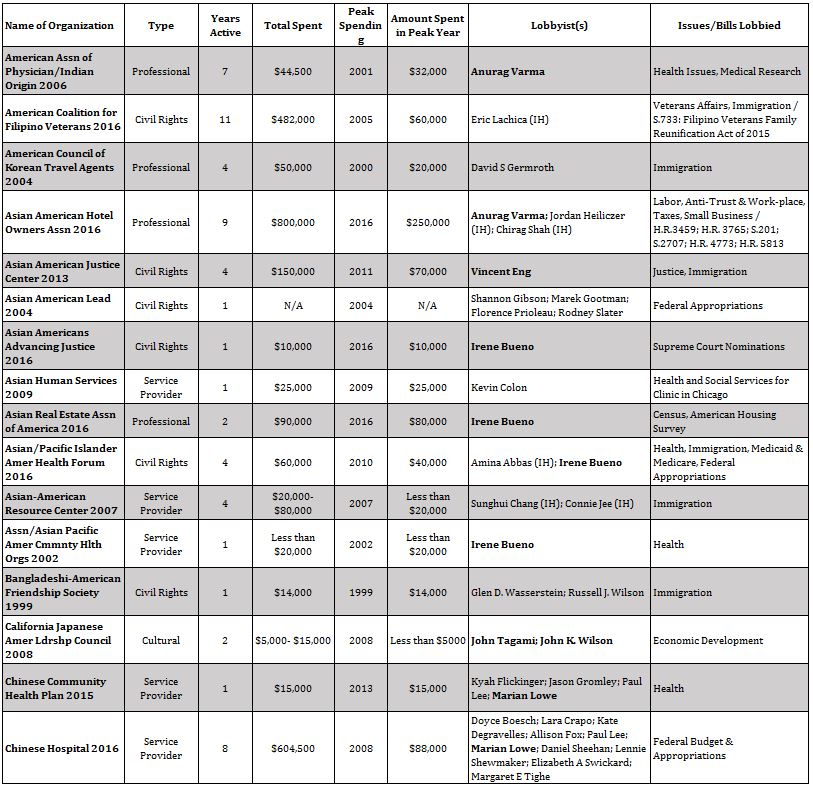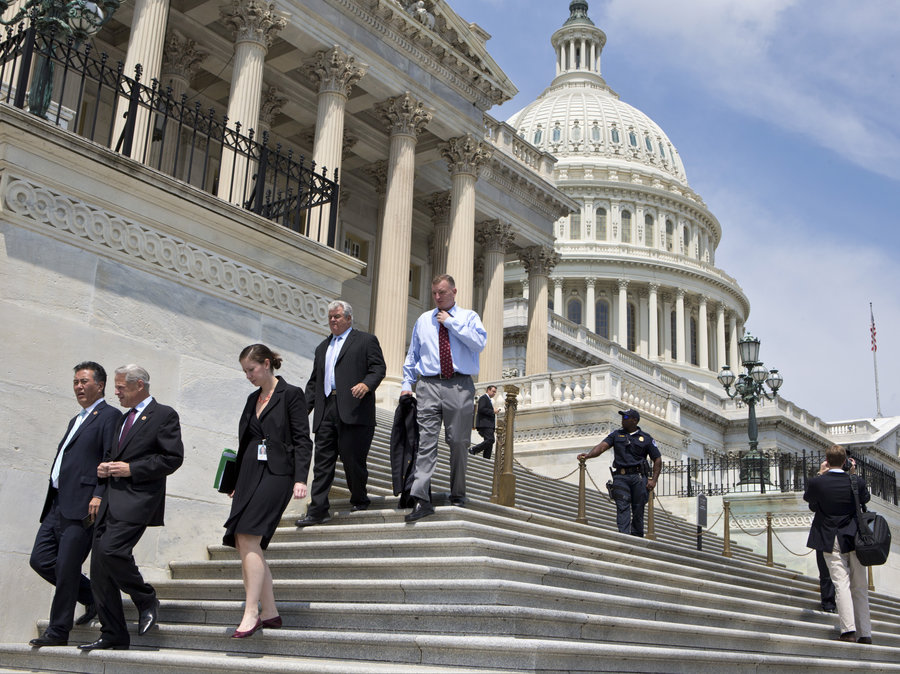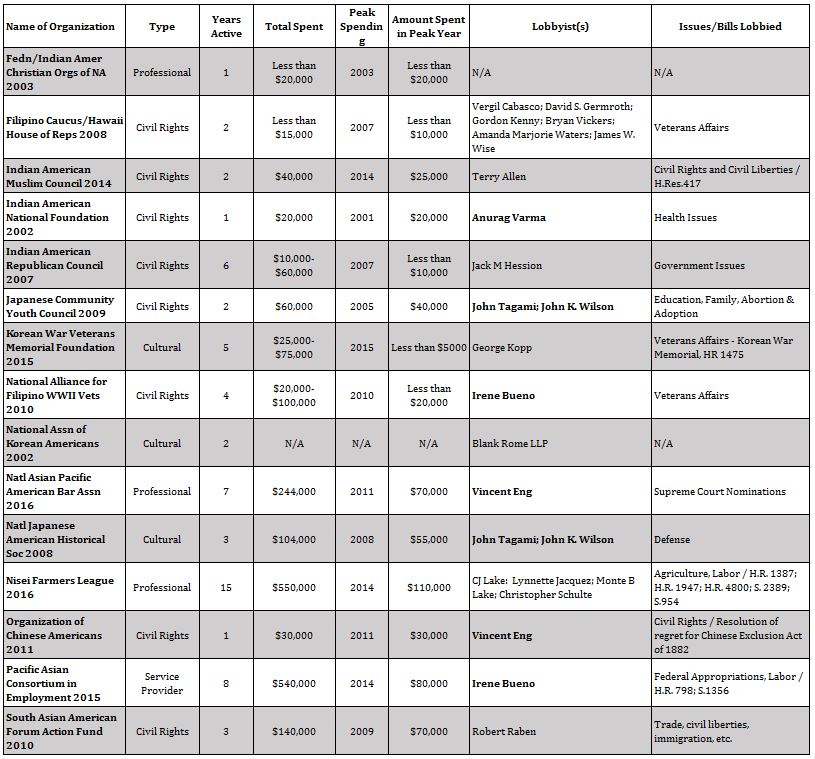This piece was published in the 27th print volume of the Asian American Policy Review.
Despite its dubious reputation, lobbying has evolved into a platform for minority interest groups to voice their concerns. By leveraging this “fourth branch of government,” racially affiliated minority interest groups directly appeal and advocate to members of Congress. Organizations like the National Association for the Advancement of Colored People (NAACP) have fought for the civil rights of African Americans since the early 1900s and now annually lobby on dozens of bills.[1] Similarly, the National Council de La Raza (NCLR) fights for the rights of Latino Americans through constant advocacy on Capitol Hill.[2] As the fastest-growing minority in America within the last ten years, and with 13.2 percent of all Asian American Pacific Islanders (AAPIs) still living in poverty, AAPIs need to advocate for and promote the wellbeing of their underserved communities.[3] Federal lobbying provides minority interest groups an opportunity to educate the country’s most powerful policy decision makers on the concerns facing minority communities. Without a unified voice on Capitol Hill, the AAPI community risks erasure of their struggles and a continued false assumption that AAPIs require no political or social support.
This piece will provide a definition of lobbying, an overview of two historic AAPI advocacy groups, a survey of current AAPI-affiliated lobbying activity from the late 1990s to now, and a look into the future lobbying considerations for AAPIs. By examining the historic origins and current state of AAPI lobbying, AAPI advocates can identify barriers and opportunities for refining lobbying practices at the federal level.
Lobbying: Definitions and Disclosures
Information on current lobbying activity comes from the Center of Responsive Politics’ online database, OpenSecrets, which captures federal lobbying information recorded by the Senate office of public records. The Lobbying Disclosure Act (LDA) of 1995 defines lobbying activities as any oral, written, or electronic communication to a covered official.[4] Under the LDA, individuals who retain a client for compensation, make more than one contact, write or speak with a covered official about legislation or policy making, or spend at least 20 percent of their time lobbying in the next six months, must register as a lobbyist.[5] An organization is considered a lobbying firm if their lobbying revenue exceeds $5,000 in a six-month period, or if lobbying expenses exceed more than $20,000.
Due to the high expenditures listed in the criteria, lower-resource advocacy activities, such as grassroots or social media advocacy efforts, are not registered as lobbying. Furthermore, groups may spend just under 20 percent of their time lobbying and bypass the reporting requirement. Finally, the IRS provides vague restrictions on lobbying by 501(c)(3) nonprofits, stating “[a] 501(c)(3) organization may engage in some lobbying, but too much lobbying activity risks loss of tax-exempt status.”[6] The IRS limit on lobbying activity is “generally based upon the size of the organization and may not exceed $1,000,000,” another vague criterion.[7] As a result, 501(c)(3)s may under-utilize their lobbying power for fear of violating the law.[8]
Past: Historic AAPI Advocacy at the JACL and OCA
The early origins of several racially affiliated lobbying groups have undoubtedly paved the way for the current state of minority group lobbying. Starting in the 1900s, historic associations like the NAACP, the NCLR, the Japanese American League of Citizens (JACL), and OCA — Asian Pacific American Advocates (OCA), galvanized African Americans, Latino Americans, Japanese Americans, and Chinese Americans to promote and protect their civil rights. However, while the former two associations expanded their lobbying efforts beyond their original mission, the latter two AAPI-affiliated groups effectively lobbied for historic reparations, but filed only one federal lobbying disclosure since 1998, indicating low lobbying activity at the federal level.
Formed in 1929, the Japanese American Citizens League lobbied for legislation to expand the rights of Japanese Americans. While criticized for not leveraging its political power to fight against the incarceration of Japanese Americans during World War II, the JACL lobbied heavily for the Civil Liberties Act of 1988.[9] The act granted $25,000 as reparations to surviving Japanese Americans whom the US government placed in internment camps during World War II. Since the Civil Liberties Act of 1988, the JACL actively spoke out in support of civil rights issues related to marriage, segregation, and immigration. However, while it is possible JACL continued to expend substantial resources on political advocacy at the state or local level, the JACL is neither registered as a lobbying client nor listed as an organization on OpenSecrets. This indicates the JACL has not engaged in lobbying as defined by the LDA of 1995.
The second-oldest and most well-known AAPI advocacy organization is the OCA – Asian Pacific American Advocates. Formerly known as the “Organization of Chinese Americans,” the group started in 1973 and is now a registered 501(c)(3) with over 100 chapters. The organization’s website features an advocacy section and policy objectives that include immigration, education, fair treatment, and broadband access. Despite its clear policy agenda, the OCA’s only recorded lobbying activity is spending $30,000 in 2011 to hire lobbyist Vincent Eng to press for a resolution of a congressional statement of regret for the passage of the 1882 Chinese Exclusion Act.[10] Initially a ten-year moratorium that Congress extended for forty-one years before finally repealing the Act in 1943, the 1882 Chinese Exclusion Act prohibited all immigration of Chinese laborers and revoked citizenship from Chinese immigrants already residing in the United States. Lobbying for the resolution by the OCA proved fruitful, as the resolution passed the Senate in 2011 and the House of Representatives in 2012. The resolution was sponsored by Representative Judy Chu in the House, a Chinese-American member who is currently the acting chair of the Congressional Asian Pacific American Caucus (CAPAC) and Senator Scott Brown in the Senate. Since then, the OCA has not engaged in any formal federal lobbying that required formal disclosure on OpenSecrets.
Present: New AAPI Lobbying Groups Emerging
A survey of OpenSecrets reveals new AAPI groups are emerging and engaging in federal lobbying specific to AAPI ethnicities. Table 1 compiles information on AAPI-affiliated groups currently employing lobbyists at the federal level.[11] Any lobbying clients clearly aimed at only improving US foreign relations or trade, such as the Korean International Trade Association, were excluded. Based on their mission statements and the issues for which they lobbied, lobbying clients were sorted into four categories: “Professional,” “Civil Rights,” “Service Provide,” and “Cultural.”[12] Peak spending year, peak spending amount, and total expenditures are included to indicate intensity of lobbying efforts. For a few organizations, upper and lower bounds are given for total amount spent to account for estimates listed in lobbying reports. The table uses each organization’s peak spending year as a marker for the year when the most lobbying activity occurred. Lobbyists, issues, and bills listed correspond with each organization’s peak spending year. Furthermore, lobbyists who worked for more than one organization listed on the table are indicated in bolded font.

Table 1: Asian American Pacific Islander Lobbying Clients Listed on OpenSecrets
The diversity of the AAPI community includes a wide array of socioeconomic backgrounds and unique lived experiences, which results in advocacy groups splintered by ethnicity. Out of the thirty-one groups, only five represent all AAPIs and are not affiliated with a professional organization. Only seven of the eighteen AAPI ethnicities identified by the White House Initiative on AAPI appear with affiliations to lobbying clients. Additionally, two-thirds of the groups have four or less years of documented lobbying experience. Fifteen, roughly half of the groups, focus on advocating for civil rights and civil liberties. Seven groups are professional associations, six are direct service providers, and three focus on cultural issues.
Increased amounts spent on lobbying allows for greater access and engagement with policy decision makers.[13] However, researchers dispute whether this access and greater overall lobbying expenditures influence favorable policy changes for an interest group.[14] Regardless, spending amounts do indicate level of advocacy effort and involvement in affecting policy changes. The top four AAPI-affiliated organizations with highest total expenditures include the Asian American Hotel Owners Association (AAHOA) at $800,000 over nine years, the Chinese Hospital ($604,500 over eight years), the Nisei Farmers League ($550,000 over fifteen years), and the Pacific Asian Consortium for Employment (PACE) at $540,000 over eight years. The combined total expenditures of all thirty-one AAPI organizations would equal $3,860,200, still about $3 million shy of the lobbying giants of other racial minority groups. For comparison, the NAACP has spent $6,884,892 on lobbying since 1999, and the NCLR has spent $6,849,380 since 1998, far beyond what any individual AAPI organization spends on lobbying.[15] The discrepancy in AAPI lobbying spending may account for the lack of awareness and political engagement at the federal level with AAPI communities and concerns.
AAPI lobbying activities correlate with the relative financial capacities of each AAPI community. Out of all thirty-one AAPI organizations, only two maintain corresponding political action committees (PACs): the AAHOA and the Nisei Farmers League. Aside from the American Coalition for Filipino Veterans, the two groups have the longest histories in lobbying. The Asian American Hotel Owners Association (AAHOA) is a primarily Indian American organization, and the Nisei Farmers League is Japanese American, representing two of the wealthiest AAPI communities.[16] On the other hand, some AAPI ethnicities remain completely absent from the lobbying database. The terms “Pakistani” and “Vietnamese” returned organizations and PACs on OpenSecrets, but no lobbying clients, indicating no organizations explicitly affiliated with the Pakistani or Vietnamese community conduct, lobbying at a federally regulated threshold. Hmong and Laotian lobbying clients mostly consisted of foreign relations groups, but OpenSecrets lists no PACs or other organizations connected to these ethnic groups. Along with Cambodians, these five AAPI ethnicities experience some of the highest rates of poverty among all AAPI communities.[17] Organizations advocating for these groups may engage in advocacy work that requires fewer resources, such as grassroots or social media advocacy at the state or local level, and therefore is not captured in OpenSecrets. In any case, increasing lobbying to covered officials for these ethnic communities is essential to raising awareness of underserved AAPIs.
Future: For Further Consideration
Future studies on this topic should delve deeper into where AAPIs advocacy efforts are focused, and the barriers to increasing advocacy activity at the federal level. For comparison, research could survey individual organizations that lobby and advocate for African American and Hispanic/Latino American civil rights, or any other racially affiliated lobbying groups. An investigation into the bills for which these individual groups lobby, whether they create temporary “lobbying blocks,” and the success of their efforts would give further insight into the effectiveness of coalitions. Further study could also examine groups in the minority group lobbying space, such as LGBTQ lobbying groups, and how they built their presence in lobbying. Asian American PACs, such as the APIA Victory Fund and the 80-20 Initiative have also played a large role in generating donations and encouraging AAPIs to become a “swing vote” in the most recent elections. An increase of AAPI political voice through PACs unrelated to professional associations and the increase of AAPIs in office may shift access to lobbying for AAPIs.
Another study could examine the value in creating a national lobbying coalition for AAPIs, similar in size and scope to the NAACP and NCLR. Building a formal coalition would allow the AAPI community to leverage the different experiences, resources, and connections of these various AAPI groups. In fact, there is historic precedent and practice in AAPI communities building coalitions. In 1988, 350 AAPI leaders created a statewide lobbying group to influence higher education in California.[18] Many speakers at the coalition emphasized AAPI success in carrying out their agenda depended on their ability to form coalitions with other groups with similar concerns, which included other minority groups. A formalized lobbying coalition would cement these relationships, circumventing the need to reinvent the wheel each time an issue affecting AAPIs arises.
Building a coalition would also empower individual AAPI organizations to lobby more. In a study on interest group lobbying, Thomas Holyoke found coalition membership increased the probability of an individual interest group’s lobbying by 43 percent.[19] Groups were more willing to step out when other more influential groups took the lead.
Furthermore, the AAPI lobbying giant may already exist. Currently, the National Council of Asian Pacific Americans (NCAPA) provides a platform for over thirty-five national AAPI organizations. As a coalition of AAPI groups, NCAPA’s mission is to strive “for equality and justice by organizing our diverse strengths to influence policy and shape public narratives.” An analysis of the barriers to lobbying for NCAPA and its members may better inform the path that NCAPA could follow.
Conclusion
It is undoubtedly important to recognize the nature of AAPI advocacy, and thus lobbying, is different from that of other racially affiliated civil rights advocacy groups. With many different ethnicities, population numbers, financial capacities, and languages, AAPI communities are culturally diverse and socioeconomically stratified. AAPIs do not share a history of slavery and civil resistance like the African American community, nor do they share a language like the Hispanic/Latin(x) community. However, these differences should not hinder the extent to which AAPIs engage with the political process and the advocacy arena. AAPIs should and can collectively address the issues that statistically affect only some fractions of our population. By continuing to investigate and examine the barriers to and opportunities for AAPI advocacy, the AAPI community can better leverage lobbying to amplify the needs of our communities.
References
[1] “About,” National Council of Asian Pacific Americans, n.d. Accessed 22 January 2017.
[2] “About Us,” National Council of La Raza, n.d. Accessed 22 January 2017.
[3] “Moving Beyond the Model Minority Myth,” Congressional Asian Pacific American Caucus, n.d. Accessed 21 January 2017; “Key Facts and Figures on Asian Americans and Pacific Islanders,” White House Initiative on Asian American Pacific Islanders, n.d. Accessed 21 January 2017.
[4] A covered official is defined by the Lobbying Disclosure Act of 1995 as the president or vice president, members of Congress, an elected officer of either the House or the Senate, officers and employees of the executive office of the president, any official serving in an executive level I through V position, any member of the uniformed services serving at grad O-7 or above, Schedule C employees, and any individual working for a member, committee, leadership of the Senate or House, joint committee of Congress, a working group or caucus for members, and any other legislative branch employee. Lobbying Disclosure Act, Section 3.
[5] “Lobbying Disclosure Act Guidance: Section 4—Lobbying Registration,” US House of Representatives, 31 January 2017. Accessed 12 February 2017.
[6] “Lobbying,” Internal Revenue Service, n.d. Accessed 12 February 2017.
[8] “Annual Lobbying on Non-Profits, 2016,” OpenSecrets.org, 2016. Accessed 21 January 2017.
[9] Yoshino, William, and John Tateishi. “The Japanese American Incarceration: Journey to Redress,” Japanese American Citizens League, n.d Access 20 January 2017.
[10] “Chinese Exclusion Act (1882),” OurDocuments.gov, n.d. Accessed 18 January 2017.
[11] The following terms were searched on OpenSecrets to compile the table: “Asian”, “Chinese”, “Japanese”, “Nisei”, “Korean”, “Filipino”, “Laotian”, “Southeast”, “Indian”, “Cambodia”, “Bangladesh”, “Hawaii”, “Polynesia”, “Hmong”, “Thai”, “Taiwan” “Indonesia”, “Pakistan”, “Guam”, “Chamorro”, “Samoa”, and “Vietnamese.”
[12] “Professional” for professional associations with members of a defined occupation; “Civil Rights” for groups that lobby on civil rights and civil liberties; “Service Provider” for groups that provide direct health care or social services; and “Cultural” for groups preserving culture and heritage.
[13] McKay, Amy, “Buying Policy? The Effet of Lobbyists’ Resources on Their Policy Success,” Political Research Quarterly Vol. 65, Issue 4 (New York: Sage Publications, 2012).
[14] Leech, Beth L., et. al., “Does Money Buy Power? Interest Group Resources and Policy Outcomes,” Midwest Political Science Association, 2007.
[15] “NAACP: Client Profile, Summary, 2016,” OpenSecrets.org, 25 January 2017. Accessed 12 February 2017.
[16] “Key Facts and Figures on Asian Americans and Pacific Islanders,” White House Initiative on Asian American Pacific Islanders (WHIAAPI), n.d. Accessed 21 January 2017.
[17] Ibid.
[18] Jaschik, Scott, “350 Asian-American Leaders Create Statewide Lobbying Group to Influence the Politics of Higher Education in California,” The Chronicle of Higher Education Vol. 34, No. 26 (Washington, DC: Chronicle of Higher Education, 1988): A21, A24..
[19] Holyoke, Thomas, “Choosing Battle Grounds: Interest Group Lobbying Across Multiple Venues,” Political Research Quarterly Vol. 56, No. 3 (New York: Sage Publications, September 2003): 325-336.
Recommended Citation
Chang, Claris. “Asian American Lobbying: Past, Present, and Future.” Asian American Policy Review 27 (2017): 75-83.

